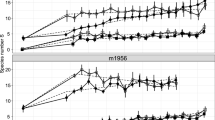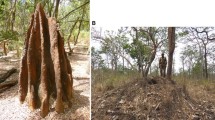Abstract
On the volcanically devastated Pumice Plain of Mount St. Helens, plant species colonized microsites differentially. Peak colonization did not occur in the same microsites as peak establishment and growth. In addition, observed microsite colonization patterns differed between years. Two studies were conducted. The first assessed seedling establishment and growth from seeds sown at different microsites. The second assessed colonization into four microsite types that were constructed on the Pumice Plain. Hypochaeris radicata was the most common species to survive when the same number of seeds of four species were planted; however, Anaphalis margaritacea was the most common colonizer of microsites. Microsites with the largest biomass plants in the first study generally had the highest colonization in the second study. Sites that do not possess features to trap seeds, such as flats and ridges, are not opportune places for a plant to grow since there is little microclimatic or substrate amelioration. Thus, flat microsites had low biomass in the establishment experiment due to the lack of amelioration and contained few plants in the colonization experiment due to a lack of seed trapping mechanisms. These results show that in the primary successional landscape of Mount St. Helens microsites are critical to revegetation dynamics. Changes in the pattern of microsite colonization between years emphasizes the dynamic nature of the landscape and the important influences of climate, substrate amelioration and seed rain to plant establishment.
Similar content being viewed by others
References
Allen, M. F. 1991. The Ecology of Mycorrhizae. Cambridge University Press, New York.
Bishop, J. G. & Schemske, D. W. 1998. Variation in flowering phenology and its reproductive consequences in Lupinus lepidus colonizing Mount St. Helens. Ecology In Press.
Chapin, D. M. 1995. Physiological and morphological attributes of two colonizing plant species on Mount St. Helens. Am. Midland Nat. 133: 76–87.
Clapperton, M. J. & Reid, D. M. 1992. A relationship between plant growth and increasing VA mycorrhizal inoculum density. New Phytol. 120: 227–234.
Clements, F. E. 1916. Plant Succession: an Analysis of the Development of Vegetation. Carnegie Institute of Washington Publication 242.
Davidson, R. L. 1969. Effects of soil nutrients and moisture on root/shoot ratios in Lolium perenne L. and Trifolium repens L. Ann. of Bot. 33: 571–577.
del Moral, R. & Bliss, L. C. 1993. Mechanisms of primary succession: insights resulting from the eruption of Mount St. Helens. Adv. Ecol. Res. 24: 1–66.
del Moral, R., Titus, J. H. & Cook, A. M. 1995. Early primary succession on Mount St. Helens, Washington, USA. J. Veg. Sci. 6: 107–120.
del Moral, R. & Wood, D. M. 1988. Dynamics of herbaceous vegetation recovery on Mount St. Helens, Washington, USA, after a volcanic eruption. Vegetatio 74: 11–27.
del Moral, R. & Wood, D. M. 1993. Early primary succession on the volcano Mount St. Helens. J. Veg. Sci. 4: 223–234.
Edwards, J. S. & Sugg, P. 1993. Arthropod fallout as a resource in the recolonization of Mount St. Helens. Ecology 73: 954–958.
Eriksson, O. & Fröberg, H. 1996. 'Windows of opportunity' for recruitment in long-lived clonal plants: experimental studies of seedling establishment in Vaccinium shrubs. Can. J. Bot. 74: 1369–1374.
Ferris, R. S. 1988. Effects of microwave oven treatment on microorganisms in soil. Phytopathology 74: 121–126.
Fowler, N. L. 1986. Microsite requirements of germination and establishment of three grass species. Amer. Midl. Nat. 115: 131–145.
Halpern, C. B. & Harmon, M. E. 1983. Early plant succession on the Muddy River mudflow, Mount St. Helens. Am. Midl. Nat. 110: 97–106.
Hendrix, L. B. 1981. Post-eruption succession on Isla Fernandina, Galapagos. Madroño 28: 242–254.
Hitchcock, C. L. & Cronquist, A. 1973. Flora of the Pacific Northwest. University of Washington Press, Seattle, Washington.
Jongman, R. H. G., ter Braak, C. J. F. & van Tongeren, O. F. R. 1987. Data Analysis in Community and Landscape Ecology. Wageningen, Pudoc.
Lamont, B. B., Witkowski, E. T. F. & Enright, N. J. 1993. Post-fire litter microsites: safe for seeds, unsafe for seedlings. Ecology 74: 501–512.
Mazzoleni, S. & Ricciardi, M. 1993. Primary succession on the cone of Vesuvius. Pp. 101–112. In: Miles, J. & Walton, D. W. H. (eds), Primary Succcession on Land. Blackwell Scientific Publications, London.
Morris, W. F. & Wood, D. M. 1989. The role of Lupinus lepidus in succession on Mount St. Helens: Facilitation or inhibition? Ecology 70: 697–703.
Nakashizuka, T., Iida, S., Suzuki, W. & Tanimoto, T. 1993. Seed dispersal and vegetation development on a debris avalanche on the Ontake volcano, Central Japan. J. Veg. Sci. 4: 537–542.
Norusis, M. J. 1993. SPSS for Windows Base System User's Guide Release 6.0. SPSS Inc., Chicago.
Oner, M. & Oflas, S. 1977. Plant succession on the Kula volcano in Turkey. Vegetatio 34: 55–62.
Pacific Northwest River Basins Commission. 1969. Climatological Handbook Columbia Basin States. Vol. 1, Part A and Vol. 2. Meterology Committee, Pacific Northwest River Basins Commission, Portland, Oregon.
Reynolds, G. D. & Bliss, L. C. 1986. Microenvironmental investigations of tephra covered surfaces at Mount St. Helens. Pp. 147–152. In: Keller, S. A. C. (ed.), Mount St. Helens: Five Years Later. Eastern Washington State University Press, Cheney, Washington.
Schupp, E. W. 1995. Seed-seedling conflicts, habitat choice, and patterns of plant recruitment. Am. J. Bot. 82: 399–409.
Smilauer, P. 1993. CanoDraw 3.0. Environmental Change Research Centre, University College, London.
Stribley, D. P. 1987. Mineral nutrition. Pp. 59–70. In: Safir, G. R. (ed.), Ecophysiology of VA Mycorrhizal Plants. CRC Press, Boca Raton, Florida.
Struik, G. J. & Bray, J. R. 1970. Root-shoot ratios of native forest herbs and Zea mays at different soil-moisture levels. Ecology 51: 892–893.
ter Braak C. J. F. 1990. CANOCO – a FORTRAN program for CANOnical Community Ordination by [partial] [detrended] [canonical] correspondence analysis, principal components analysis and redundancy analysis (version 3.10). Microcomputer Power, Ithaca.
ter Braak, C. J. F. 1994. Canonical community ordination. Part I: Basic theory and linear methods. Ecoscience 1: 127–140.
ter Braak, C. J. F. & Prentice, I. C. 1988. A theory of gradient analysis. Adv. Ecol. Res. 18: 271–317.
Timmins, S. 1983. Mt. Tarawera: 1. Vegetation types and successional trends. New Zealand J. Ecol. 6: 99–105.
Titus, J. H. 1995. The role of mycorrhizae and microsites in primary succession on Mount St. Helens. Ph. D. dissertation, Department of Botany, University of Washington, Seattle, Washington.
Titus, J. H. & del Moral, R. 1998. The role of mycorrhizal fungi and microsites in primary succession on Mount St. Helens. Am. J. Bot., in press.
Tsuyuzaki, S. 1989. Analysis of revegetation dynamics on the volcano Usu, northern Japan, deforested by 1977–1978 eruptions. Am. J. Bot. 68: 1468–1477.
Tsuyuzaki, S. 1991. Species turnover and diversity during early stages of vegetation recovery on the volcano Usu, northern Japan. J. Veg. Sci. 2: 301–306.
Tsuyuzaki, S. & Titus, J. H. 1996. Vegetation development patterns in erosive areas on the Pumice Plains of Mount St. Helens. American Midland Naturalist 135: 172–177.
Willson, M. F. 1983. Plant Reproductive Ecology. John Wiley and Sons, New York.
Wood, D. M. & del Moral, R. 1987. Mechanisms of early primary succession in subalpine habitats on Mount St. Helens. Ecology 68: 780–790.
Wood, D. M. & Morris, W. F. 1990. Ecological constraints to seedling establishment on the Pumice Plains, Mount St. Helens, Washington. Am. J. Bot. 77: 1411–1418.
Zar, J. H. 1984. Biostatistical Analysis. Second edition. Prentice-Hall, Inc., Englewood Cliffs, New Jersey.
Author information
Authors and Affiliations
Rights and permissions
About this article
Cite this article
Titus, J.H., del Moral, R. Seedling establishment in different microsites on Mount St. Helens, Washington, USA. Plant Ecology 134, 13–26 (1998). https://doi.org/10.1023/A:1009765502741
Issue Date:
DOI: https://doi.org/10.1023/A:1009765502741




